
Museum für Ostasiatische Kunst
In the location's words:
Stop: Universitätsstr.
Cologne has the oldest museum of East Asian art in the whole of Europe and the only one in Germany. Important areas of the collection include sacred bronzes, early ceramics, stone sculptures and porcelain from China, wooden sculptures, screens, lacquer art and woodblock prints from Japan, celadon and Buddhist paintings from Korea as well as modern Chinese painting and Japanese calligraphy. The museum building, which opened in 1977, is a highlight: it was designed by Kunio Maekawa, a student of Le Corbusier. With its strict, clearly structured cubes, it draws on old Japanese traditions, but at the same time develops a new, modern design language. The landscaped garden designed by Japanese sculptor Masayuki Nagare forms the center of the complex.
This content has been machine translated.Öffnungszeiten
Future events by Museum für Ostasiatische Kunst

Rautenstrauch-Joest-Mus…

Kunsthafen im Kunsthaus…

NS-Dokumentationszentru…

Kollwitz Museum Köln

Das Museum des Schmerze…

Deutsches Sport & Olymp…

Museum Ludwig

MiQua. LVR-Jüdisches Mu…

Simultanhalle

artrmx e.V.

Schokoladenmuseum Köln
MAKK Museum für Angewan…

Super Candy Pop Up Muse…

Kölnisches Stadtmuseum

Weinmuseum Köln

Museum Schnütgen

Atombunker Köln-Kalk/DO…

Tanzmuseum des Deutsche…

Museum Raffael Becker

FUHRWERKSWAAGE







Gemeinsam Events erleben
Events werden noch schöner wenn wir sie teilen! Deshalb kannst du dich jetzt mit Friends und anderen Usern vernetzen um Events gemeinsam zu besuchen. Loslegen